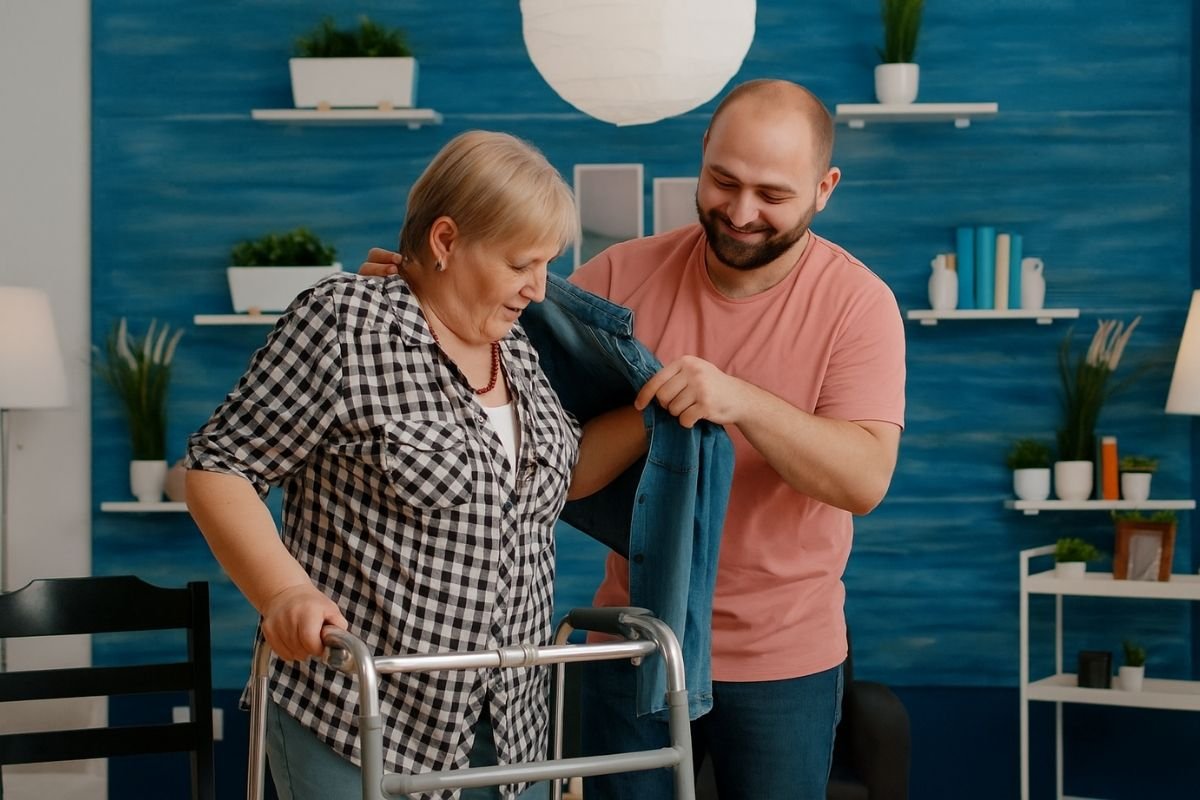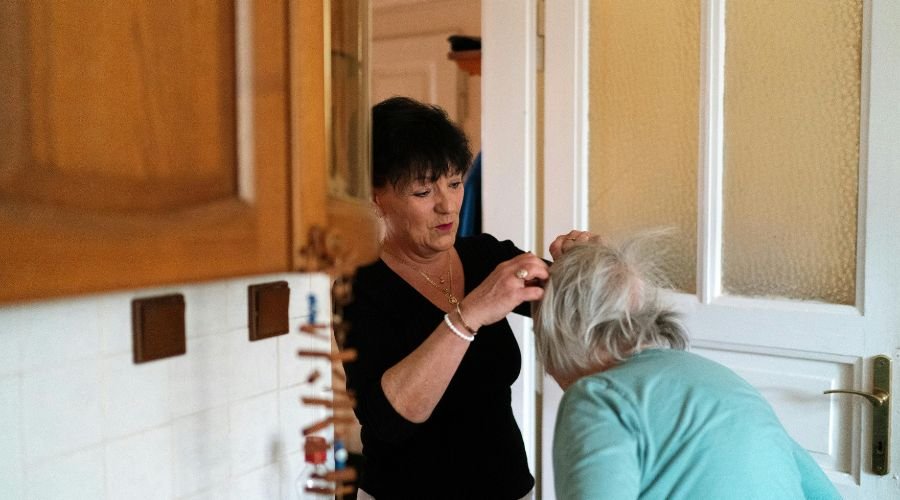Importance of Dressing and Undressing Assistance
Dressing and undressing are essential daily activities that contribute to a client’s comfort, hygiene, and self-esteem. For individuals with mobility challenges or age-related conditions, caregiver assistance ensures these tasks are performed safely and respectfully.
1. Physical Benefits
- Ensures cleanliness by helping clients wear fresh clothes, reducing the risk of skin issues like rashes or infections caused by soiled or tight garments.
- Prevents discomfort or injury by selecting properly fitting clothing and avoiding strain during dressing.
2. Emotional Benefits
- Promotes self-esteem and dignity by ensuring clients look presentable, which can positively impact their mood and confidence.
- Encourages independence when clients are supported to participate in the process, fostering a sense of autonomy.
3. Health Monitoring
- Dressing provides an opportunity to observe the client’s skin for signs of irritation, sores, or bruises. Early detection of such issues can prevent complications.
- Allows caregivers to assess physical changes, such as swelling or joint stiffness, that may require medical attention.
Role of Adaptive Clothing
Adaptive clothing is a valuable tool for both clients and caregivers. Features like Velcro closures, magnetic buttons, and open-back designs simplify the dressing process while preserving the client’s dignity. These garments reduce physical strain on both parties and make dressing quicker and more comfortable. For individuals with conditions like arthritis or dementia, adaptive clothing minimizes frustration and enhances safety during dressing.
By combining compassionate care with practical solutions like adaptive clothing, caregivers can transform dressing into a positive experience. This approach not only improves physical well-being but also nurtures emotional health, fostering a sense of respect and independence for the client.

Preparing for Dressing and Undressing Assistance
Proper preparation is essential to ensure that dressing and undressing assistance is safe, efficient, and respectful. By assessing the client’s needs, gathering the necessary supplies, preparing the environment, and communicating effectively, caregivers can create a supportive experience.
1. Assess the Client’s Needs
- Determine the level of assistance required: full assistance, partial support, or supervision.
- Review the care plan for specific instructions regarding mobility limitations, sensitivities (e.g., pain), or use of adaptive clothing.
- Consider physical challenges such as restricted range of motion or cognitive impairments that may affect the dressing process.
2. Gather Necessary Supplies
- Prepare clean clothing, including underwear, socks, tops, bottoms, and adaptive clothing with features like Velcro closures or elastic waistbands.
- Ensure comfortable footwear or slippers with non-slip soles are available.
- Have assistive devices on hand if needed, such as a dressing stick, sock aid, or long-handled shoehorn.
3. Prepare the Environment
- Ensure the room is warm to prevent discomfort during dressing or undressing.
- Arrange a safe seating area, such as a sturdy chair or bed with adequate back support.
- Remove hazards like clutter, loose rugs, or slippery floors to create a safe workspace.
- Provide adequate lighting to enhance visibility and reduce risks.
4. Communicate with the Client
- Explain each step of the process to alleviate anxiety and encourage cooperation. For example: “I’ll help you put on your shirt first.”
- Respect their preferences by asking about clothing choices and sequence (e.g., “Would you like to wear this shirt today?”).
- Use clear and simple language while maintaining a calm tone to ensure understanding.
- Encourage participation by allowing them to perform tasks they are capable of managing independently.
By following these steps, caregivers can ensure that dressing and undressing assistance is both functional and dignified. This preparation not only enhances safety but also fosters independence and comfort for the client.
Assisting with Dressing
Helping a client with dressing is a delicate task that requires patience, respect, and attention to their comfort and independence. Caregivers should aim to provide the necessary support while encouraging clients to participate as much as possible. Here’s how this can be done:
1. Encourage Independence
- Allow the client to perform tasks they can manage independently, such as pulling up socks or fastening buttons.
- Offer verbal prompts or step-by-step guidance, such as, “Let’s start with your socks,” to help them stay engaged in the process.
- Provide physical assistance only when necessary, fostering a sense of autonomy and confidence.
2. Dressing the Upper Body
- For shirts or tops:
- Hold the shirt open at the neck and sleeves for easy access.
- Guide one arm into a sleeve while supporting their arm if needed.
- Repeat the process for the other arm.
- If it’s a pullover shirt, gently lift it over their head; if it’s a buttoned shirt, adjust it around their shoulders and fasten buttons or zippers carefully.
- Ensure the shirt is smooth and comfortable, avoiding tightness or irritation.
- If limited mobility is present on one side (e.g., after a stroke):
- Always start dressing from the weaker side first, as it is harder for them to assist with that side.
3. Dressing the Lower Body
- For pants or skirts:
- Hold the waistband open and guide one leg into the pant leg while supporting their foot if necessary.
- Repeat with the other leg before pulling the pants gently up to their waist.
- Ensure they are seated securely or supported if standing during this process.
- For socks:
- Roll each sock down to its toe opening for easier application.
- Slip it over their toes and gently pull it up over their heel and ankle.
- Use a sock aid if they have difficulty bending down.
- For shoes:
- Ensure shoes fit properly and fasten securely using Velcro straps or laces.
4. Adjust Clothing for Comfort
- Check that clothing is not twisted or bunched up, as this could cause discomfort or pressure sores.
- Confirm that all fasteners are secure but not too tight, ensuring both safety and comfort.
By following these steps, caregivers can provide respectful and effective assistance while maintaining the client’s dignity and promoting their independence during dressing routines.

Assisting with Undressing
Undressing assistance is as important as dressing, requiring sensitivity, respect for privacy, and attention to the client’s comfort. Caregivers should approach this task with patience and care to ensure a smooth and dignified process.
1. Provide Privacy
- Always prioritize the client’s dignity by closing doors, drawing curtains, or using a privacy screen.
- Communicate with the client throughout the process to make them feel comfortable and secure.
2. Undressing the Upper Body
- For shirts or tops:
- Begin by unfastening buttons or zippers.
- Remove the garment from the stronger arm first if the client has limited mobility (the reverse of dressing).
- If it’s a pullover shirt, gently lift it over their head while supporting their neck and shoulders as needed.
- Fold or place the removed clothing neatly nearby or in a laundry basket.
3. Undressing the Lower Body
- For pants or skirts:
- Ensure the client is seated securely before starting to avoid falls or discomfort.
- Slide the pants or skirt down gently from the waist to their knees.
- Guide each leg out of the garment one at a time, supporting their feet if necessary.
- For socks and shoes:
- Remove shoes first by loosening straps, laces, or Velcro fastenings.
- Roll socks down from the top to the toe opening and slide them off gently without pulling too hard on their feet.
4. Handle Soiled Clothing Properly
- Place dirty or soiled clothing directly into a designated laundry basket to maintain cleanliness and organization.
- If clothing is heavily soiled, follow proper hygiene protocols, such as wearing gloves and washing hands afterward.
By providing privacy, handling garments carefully, and maintaining clear communication, caregivers can ensure that undressing assistance is both respectful and efficient. This approach helps clients feel valued and comfortable while promoting their overall well-being.
Special Considerations
Caregivers must adapt their approach to dressing and undressing based on the unique needs of each client. Whether the client has limited mobility, cognitive impairments, or experiences pain, these considerations ensure safety, comfort, and dignity.
1. For Clients with Limited Mobility
- Use Assistive Devices: Incorporate tools like dressing sticks, long-handled shoehorns, or sock aids to reduce physical strain for both the client and caregiver.
- Choose Adaptive Clothing: opt for garments with Velcro fastenings, magnetic closures, or open-back designs to simplify dressing without requiring excessive movement.
- Provide Support During Transfers: Assist clients when transitioning between sitting and standing positions by using proper body mechanics and ensuring stability.
2. For Clients with Cognitive Impairments (e.g., Dementia)
- Simplify Instructions: Use clear, simple language and demonstrate each step visually to guide them through the process.
- Limit Options: Offer a small selection of clothing choices to prevent overwhelming them and encourage decision-making.
- Maintain Routine: Dressing at the same time each day can reduce confusion and foster cooperation.
3. For Clients in Pain or Discomfort
- Move Gently: Avoid sudden movements that may exacerbate pain. Communicate each step to reassure the client.
- Select Comfortable Clothing: Choose loose-fitting garments made from soft fabrics to minimize irritation and make dressing easier.
4. Adaptive Clothing Options
- Adaptive clothing is specially designed to make dressing more efficient and comfortable for clients with physical or cognitive challenges:
- Magnetic Closures: Replace traditional buttons or zippers for ease of use.
- Open-Back Designs: Allow garments to be slipped on without lifting arms or standing.
- Side-Zip Pants: Enable dressing while seated or lying down.
- Elastic Waistbands: Provide flexibility and comfort without complicated fastenings.
By tailoring dressing routines to individual needs and incorporating adaptive tools and clothing, caregivers can enhance the client’s independence and dignity while reducing physical strain. These thoughtful adjustments create a safer, more efficient caregiving environment.
Maintaining Dignity During Care
Preserving a client’s dignity is a fundamental aspect of caregiving, especially during intimate tasks like dressing and undressing. By respecting their privacy, cultural preferences, and personal choices, caregivers can provide compassionate and respectful assistance.
1. Cover Exposed Areas
- Use a towel, blanket, or sheet to cover parts of the body not being dressed or undressed. This minimizes unnecessary exposure and helps the client feel more secure and respected.
- For bedbound clients, drape a sheet over the lower half of the body while assisting with the upper half, and vice versa.
2. Respect Cultural Preferences
- Be mindful of cultural or religious beliefs regarding modesty and clothing choices. For example, some clients may prefer to have same-gender caregivers or specific types of garments that align with their values.
- Always ask about and honor these preferences to create a comfortable and respectful environment.
3. Encourage Participation
- Allow clients to make decisions about their outfits whenever possible. Offer simple choices like, “Would you prefer the blue shirt or the green one?” This promotes autonomy and helps them feel in control of their care.
- Encourage them to assist with tasks they can manage independently, such as buttoning or pulling up socks, to maintain their sense of independence.
4. Communicate Clearly
- Explain each step of the process before proceeding. For instance, say, “I’m going to help you put on your shirt now,” to reduce anxiety and build trust
- Use a calm tone and maintain eye contact to reassure the client throughout the process.
5. Create a Comfortable Environment
- Ensure the room is warm enough for undressing, close doors or curtains for privacy, and remove distractions to help the client feel at ease.
- Take your time during the task, moving gently and avoiding any actions that could cause discomfort or embarrassment.
By prioritizing privacy, respecting personal preferences, and encouraging active participation, caregivers can maintain their clients’ dignity while fostering trust and comfort during care routines.

Monitoring During Dressing/Undressing
Dressing and undressing provide valuable opportunities for caregivers to monitor a client’s physical health. By observing the skin and body for any abnormalities, caregivers can identify potential health issues early and take appropriate action.
1. Observe for Skin Changes
- Redness or Rashes: These may indicate irritation, allergic reactions, or the beginning stages of pressure sores.
- Bruises: Look for unexplained bruising, which could be a sign of falls, bumps, or underlying medical conditions like blood clotting issues.
- Pressure Sores: Pay close attention to bony areas such as the hips, heels, elbows, and tailbone for signs of pressure ulcers, especially in clients with limited mobility.
- Swelling: Check for swelling in the legs, feet, hands, or other areas that could indicate fluid retention or inflammation.
2. Document and Report Concerns
- Immediately report any unusual findings (e.g., sores, bruises, or swelling) to your supervisor or healthcare provider as per agency protocols. Early reporting ensures timely medical intervention.
- Document observations in the client’s care notes to maintain accurate records of their condition over time.
3. Assess for Pain or Discomfort
- Ask clients if they feel any pain during dressing or undressing. This may reveal underlying issues such as joint stiffness, muscle soreness, or skin sensitivity.
- Adjust your approach if the client expresses discomfort to avoid exacerbating the issue.
4. Monitor Mobility and Flexibility
- Observe how easily the client moves during dressing tasks. Difficulty bending limbs or lifting arms may indicate joint problems or reduced mobility that should be addressed.
By incorporating careful observation into dressing routines, caregivers can play an active role in monitoring their clients’ health. This proactive approach not only ensures early detection of potential issues but also contributes to a higher standard of care and overall well-being.
Safety Tips
Ensuring safety during dressing and undressing is essential for both the caregiver and the client. By following these tips, caregivers can minimize risks and create a secure environment:
1. Use Proper Body Mechanics
- Protect yourself from injury by bending at your knees, not your back, when lifting or assisting with movements such as lifting legs or helping the client stand.
- Keep your back straight and avoid twisting while providing support.
2. Ensure Client Stability
- Always have the client seated securely on a stable surface, such as a sturdy chair or bed, when dressing or undressing lower body garments.
- For clients with limited mobility, ensure they are supported during transfers between sitting and standing positions.
3. Keep Floors Hazard-Free
- Remove tripping hazards like loose clothing items, shoes, or rugs from the area.
- Wipe up any spills immediately to prevent slips.
4. Use Adaptive Tools and Clothing
- Incorporate tools like dressing sticks, sock aids, or long-handled shoehorns to reduce strain on both the caregiver and client.
- Recommend adaptive clothing with features like Velcro closures or elastic waistbands for easier dressing.
5. Maintain Proper Footwear
- Ensure both caregiver and client wear non-slip footwear to prevent falls during standing or walking activities.
6. Communicate Clearly
- Explain each step of the process to keep the client informed and reduce anxiety.
- Encourage their cooperation and participation to foster independence while maintaining safety.
By prioritizing these safety measures, caregivers can create a comfortable and secure environment that minimizes risks while promoting confidence and dignity during dressing routines.

